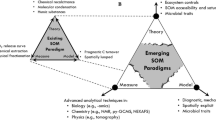Summary
Patterns of N mineralization vary widely between ecosystems, making intra- and interexperimental comparisons difficult at best. A flexible model, the Richards model, is suggested as a way of making comparisons. By changing its shape parameter, a flexible model can fit multiple mechanistic models, including first-order and logistic models. The scale-independent shape parameter (m) is a continuous variable that can be statistically analyzed to determine changes or differences in patterns. The model was tested with (1) simulations based on other mechanistic models; and with N mineralization data on soils from (2) urban and rural sites in New York; (3) forest soils in Alberta, Canada; and (4) arid and semiarid soils in Morocco. In all examples, the model was capable of fitting the data nearly as well as other specific models. With data based on the m values, soils in Morocco and organic horizons of coniferous forests in Alberta showed the same range in N mineralization patterns, although the soils varied in the amount of mineralizable N by an order of magnitude and time to reach maximum mineral N production by two-fold.
Similar content being viewed by others
References
Andren O, Paustian K (1987) Barley straw decomposition in the field: A comparison of models. Ecology 68:1190–1200
Brisbin IL Jr, White GC, Bush PB (1986a) PCB intake and the growth of waterfowl: Multivariate analyses based on a reparameterized Richards sigmoid model. Growth 50:1–11
Brisbin IL Jr, White GC, Bush PB, Mayack LA (1986b) Sigmoid growth analyses of wood ducks: The effects of sex, dietary protein and cadmium on parameters of the Richards model. Growth 50:41–50
Brisbin IL Jr, McLeod KW, White GC (1987) Sigmoid growth and the assessment of hormesis: A case for caution. Health Phys 52:553–559
Carpenter SR (1982) Comparisons of equations for decay of leaf litter in tree-hole ecosystems. Oikos 39:17–22
Davies OL, Ku JY (1977) Re-examination of the fitting of the Richards growth function. Biometrics 33:546–547
Draper NR, Smith H (1981) Applied regression analysis, 2nd edn. Wiley, New York
ElGharous M, Westermann RL, Soltanpour PN (1990) Nitrogen mineralization potential of arid and semiarid soils of Morocco. Soil Sci Soc Am J 54:438–443
Ellert BH, Bettany JR (1988) Comparison of kinetic models for describing net sulfur and nitrogen mineralization. Soil Sci Soc Am J 52:1692–1702
Fyles JW, McGill WB (1987) Nitrogen mineralization in forest soil profiles from central Alberta. Can J For Res 17:242–249
Gehan EA, Siddiqui MM (1973) Simple regression methods for survival time studies. J Am Stat A 68:848–856
Keeney DR (1982) Nitrogen-availability indices. In: Page AL, Miller RH, Keeney DR (eds) Methods of soil analysis: Part 2. Chemical and microbiological properties, 2nd edn. Am Soc Agron, Soil Sci Soc Am, Madison, Wisconsin, pp 711–733
Lieth JH, Reynolds JF (1986) Plant growth analysis of discontinuous growth data: A modified Richards function. Sci Hortic 18:301–314
Pindar JE, Wiener JG, Smith MH (1978) The Weibull distribution: A new method of summarizing survivorship data. Ecology 59:175–179
Richards FJ (1959) A flexible growth function for empirical use. J Exp Bot 10:290–300
SAS Institute Inc (1982) SAS user's guide: Statistics. SAS institute Inc. Cary, North Carolina
Schmidt SK, Simkins S, Alexander M (1985) Models for the kinetics of biodegradation of organic compounds not supporting growth. Appl Environ Microbiol 50:323–331
Simkins S, Alexander M (1984) Models for mineralization kinetics with the variables of substrate concentration and population density. Appl Environ Microbiol 47:1299–1306
Stewart DA, Essenwanger OM (1978) Frequency distribution of wind speed near the surface of the earth. J Appl Meteorol. 17:1633–1642
Venus JC, Causton DR (1979) Plant growth analysis: The use of the Richards function as an alternative to polynomial exponentials. Ann Bot 43:623–632
Vitousek PM, Gosz JR; Grier CC, Melillo JM, Reiners WA (1982) A comparative analysis of potential nitrification and nitrate mobility in forest ecosystems. Ecol Monogr 52:155–177
Wagner TL, Wu H, Sharpe PJH, Schoolfield RM, Coulson RN (1984) Modeling insect development rates: A literature review and applications of a biophysical model. Ann Entomol Soc Am 77:208–225
White GC, Brisbin IL Jr (1980) Estimation and comparison of parameters in stochastic growth models for barn owls. Growth 44:97–111
White CS, McDonnell MJ (1988) Nitrogen cycling and soil characteristics in an urban versus rural forest. Biogeochemistry 5:243–262
Yang RC, Kozak A, Smith JHG (1978) The potential of Weibull-type functions as flexible growth curves. Can J For Res 8:424–431
Zach R, Liner Y, Rigby GL, Mayoh KR (1983) Growth curve analysis of birds: The Richards model and procedural problems. Can J Zool 62:2429–2435
Zeger SL, Harlow SD (1987) Mathematical models from laws of growth to tools for biological analysis: Fifty years of growth. Growth 51:1–21
Author information
Authors and Affiliations
Rights and permissions
About this article
Cite this article
White, C.S., Marinakis, Y.D. A flexible model for quantitative comparisons of nitrogen mineralization patterns. Biol Fertil Soils 11, 239–244 (1991). https://doi.org/10.1007/BF00335841
Received:
Issue Date:
DOI: https://doi.org/10.1007/BF00335841




